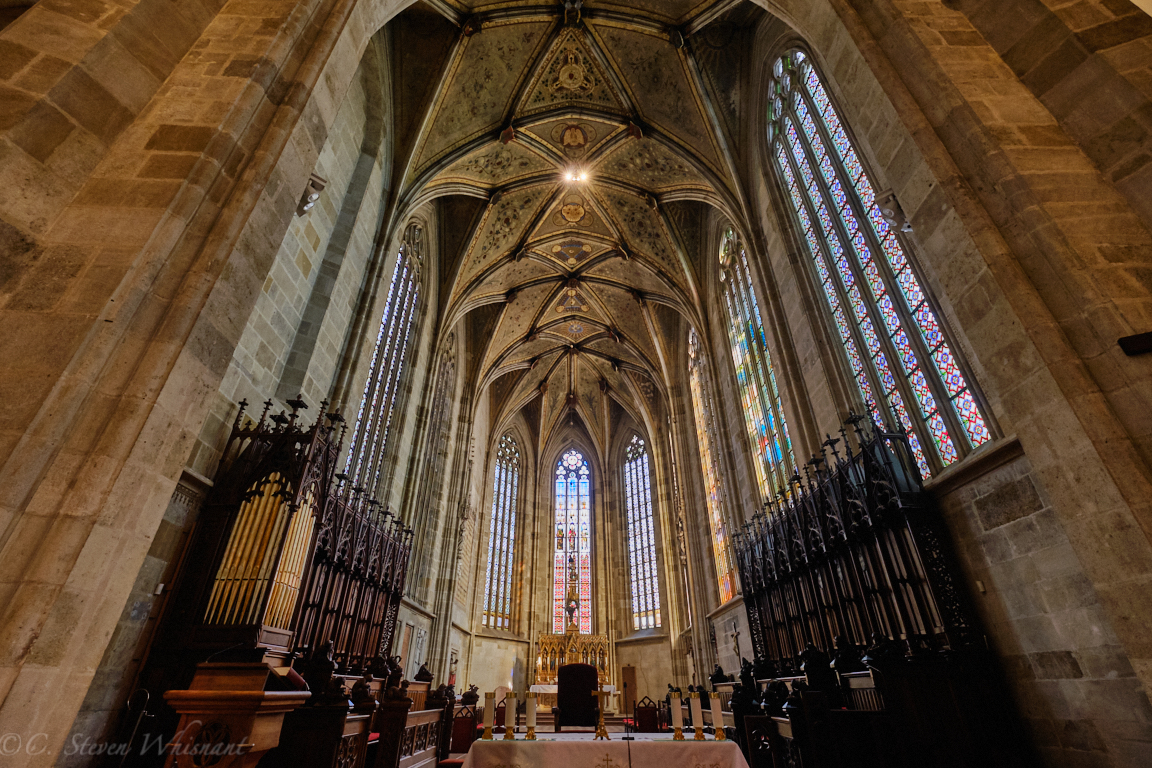The most interesting place we visited in Bratislava has to be St. Martin's Cathedral. The front of the church is an interesting place. To the left of the photo above is a large four-lane bridge connecting the rest of the city to the bridge across the Danube to Austria. The communists were not too particular about what was destroyed to build what they wanted.
The photo above shows a section of the original wall around the city. And just out of view to the right is the church.
Inside is a quiet place, an escape from the road noise. Also, we find an impressive space. The ribbed ceiling tracing the pattern above creates a relaxing geometry.
The colors of the stained glass gives the altar and quire a warmer feeling that the cold stone might suggest.
On the left side of the main altar area is the St. John the Merciful Chapel. This St. John has had and most curious path in life and death.
On the death of the Patriarch Theodore, the Alexandrians besought Emperor Phocas to appoint John his successor, which was accordingly done. One of the first steps he took was to make a list of several thousand needy persons, whom he took under his especial care. He always referred to the poor as his "lords and masters", because of their mighty influence at the Court of the Most High. He assisted people of every class who were in need.
Around farther to the left is a small chapel dedicated to private prayer.
In the main section of the nave towards the rear of the space, is the low-hung chandelier.
To the right of the altar is this statue of St. Martin dressed in a typical Hungarian Hussar uniform. He is dividing his cloak with this sword to give a portion to the beggar at his feet.
The confessionals are finely carved.
At the rear of the church is a separate room, perhaps used as a library or office of some sort now. Through the door you can see the photo of the Pope and above it is a quite ornate clock.
While other churches we've been in have had more delicately and densely packed ribbing, this one is elegant in its simplicity.
And from underneath the chandelier, we get a stronger impression of the symmetry of the building.
After a few of the tour groups passed through, I went back to the chapel for St. John the Merciful and reached in with my camera to get a couple photos.
Turns out that ol' John did as much traveling in death as he did in life.
I cannot verify who this statue represents with a missing arm, but be assured that St. John is finally at rest in here.John died in Cyprus somewhere between 616 and 620.From Cyprus his body was moved to Constantinople, then in 1249 to Venice, where there is a church dedicated to him, the Chiesa di San Giovanni Elemosinario, although his relics are preserved in another church, San Giovanni in Bragora, in a separate chapel.Another relic of him was sent by Sultan Bayezid II in 1489 to King Matthias Corvinus of Hungary. It was placed in the private Royal Chapel in Buda Castle, which was dedicated to him. Now his body lies in the St. John the Merciful Chapel in St. Martin's Cathedral in Bratislava, Slovakia.
And, just to let you know that this is, in fact, a pretty important place, it is the church in which 11 kings and queens and 8 of their consorts were coronated. Wikipedia tells us that these are:
A place filled with history and beautiful light.List of crowned kings/queens and of their consorts, with dates in parentheses:[3]
- Maximilian II (8 September 1563)
- Maria, wife of Maximilian II (9 September 1563)
- Rudolf II (25 September 1572)
- Matthias (19 November 1608)
- Anna, wife of Matthias (25 March 1613)
- Ferdinand II (1 July 1618)
- Eleonore, second wife of Ferdinand II (26 July 1622)
- Maria Anna, first wife of Ferdinand III (14 February 1638)
- Ferdinand IV (16 June 1647)
- Eleanor, third wife of Ferdinand III (6 June 1655)
- Leopold I (27 June 1655)
- Joseph I (9 December 1687)
- Charles III (22 May 1712)
- Elisabeth Christine, wife of Charles III (18 October 1714)
- Maria Theresa (25 June 1741)
- Leopold II (15 November 1790)
- Maria Ludovika, third wife of Francis I (7 September 1808)
- Caroline Augusta, fourth wife of Francis I (25 September 1825)
- Ferdinand V (28 September 1830)
 |













No comments:
Post a Comment
We enjoy hearing from our readers.